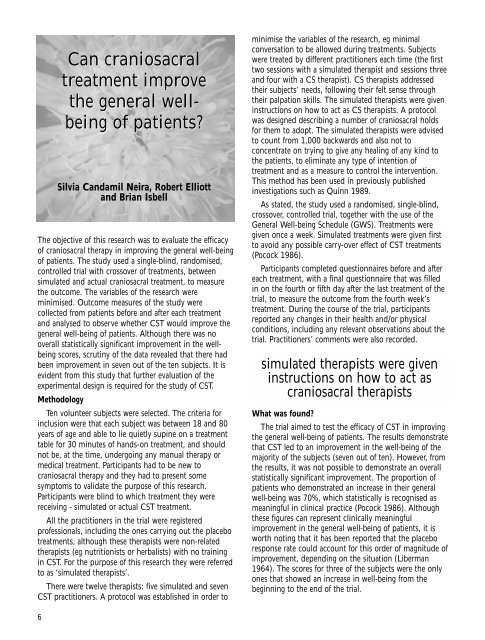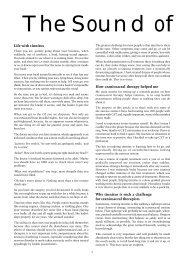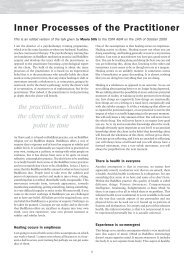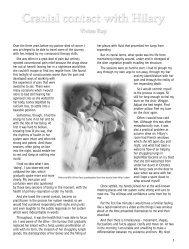Can craniosacral treatment improve the general well- being of ...
Can craniosacral treatment improve the general well- being of ...
Can craniosacral treatment improve the general well- being of ...
You also want an ePaper? Increase the reach of your titles
YUMPU automatically turns print PDFs into web optimized ePapers that Google loves.
<strong>Can</strong> <strong>craniosacral</strong><br />
<strong>treatment</strong> <strong>improve</strong><br />
<strong>the</strong> <strong>general</strong> <strong>well</strong><strong>being</strong><br />
<strong>of</strong> patients<br />
Silvia <strong>Can</strong>damil Neira, Robert Elliott<br />
and Brian Isbell<br />
The objective <strong>of</strong> this research was to evaluate <strong>the</strong> efficacy<br />
<strong>of</strong> <strong>craniosacral</strong> <strong>the</strong>rapy in improving <strong>the</strong> <strong>general</strong> <strong>well</strong>-<strong>being</strong><br />
<strong>of</strong> patients. The study used a single-blind, randomised,<br />
controlled trial with crossover <strong>of</strong> <strong>treatment</strong>s, between<br />
simulated and actual <strong>craniosacral</strong> <strong>treatment</strong>, to measure<br />
<strong>the</strong> outcome. The variables <strong>of</strong> <strong>the</strong> research were<br />
minimised. Outcome measures <strong>of</strong> <strong>the</strong> study were<br />
collected from patients before and after each <strong>treatment</strong><br />
and analysed to observe whe<strong>the</strong>r CST would <strong>improve</strong> <strong>the</strong><br />
<strong>general</strong> <strong>well</strong>-<strong>being</strong> <strong>of</strong> patients. Although <strong>the</strong>re was no<br />
overall statistically significant <strong>improve</strong>ment in <strong>the</strong> <strong>well</strong><strong>being</strong><br />
scores, scrutiny <strong>of</strong> <strong>the</strong> data revealed that <strong>the</strong>re had<br />
been <strong>improve</strong>ment in seven out <strong>of</strong> <strong>the</strong> ten subjects. It is<br />
evident from this study that fur<strong>the</strong>r evaluation <strong>of</strong> <strong>the</strong><br />
experimental design is required for <strong>the</strong> study <strong>of</strong> CST.<br />
Methodology<br />
Ten volunteer subjects were selected. The criteria for<br />
inclusion were that each subject was between 18 and 80<br />
years <strong>of</strong> age and able to lie quietly supine on a <strong>treatment</strong><br />
table for 30 minutes <strong>of</strong> hands-on <strong>treatment</strong>, and should<br />
not be, at <strong>the</strong> time, undergoing any manual <strong>the</strong>rapy or<br />
medical <strong>treatment</strong>. Participants had to be new to<br />
<strong>craniosacral</strong> <strong>the</strong>rapy and <strong>the</strong>y had to present some<br />
symptoms to validate <strong>the</strong> purpose <strong>of</strong> this research.<br />
Participants were blind to which <strong>treatment</strong> <strong>the</strong>y were<br />
receiving - simulated or actual CST <strong>treatment</strong>.<br />
All <strong>the</strong> practitioners in <strong>the</strong> trial were registered<br />
pr<strong>of</strong>essionals, including <strong>the</strong> ones carrying out <strong>the</strong> placebo<br />
<strong>treatment</strong>s, although <strong>the</strong>se <strong>the</strong>rapists were non-related<br />
<strong>the</strong>rapists (eg nutritionists or herbalists) with no training<br />
in CST. For <strong>the</strong> purpose <strong>of</strong> this research <strong>the</strong>y were referred<br />
to as ‘simulated <strong>the</strong>rapists’.<br />
There were twelve <strong>the</strong>rapists: five simulated and seven<br />
CST practitioners. A protocol was established in order to<br />
minimise <strong>the</strong> variables <strong>of</strong> <strong>the</strong> research, eg minimal<br />
conversation to be allowed during <strong>treatment</strong>s. Subjects<br />
were treated by different practitioners each time (<strong>the</strong> first<br />
two sessions with a simulated <strong>the</strong>rapist and sessions three<br />
and four with a CS <strong>the</strong>rapist). CS <strong>the</strong>rapists addressed<br />
<strong>the</strong>ir subjects’ needs, following <strong>the</strong>ir felt sense through<br />
<strong>the</strong>ir palpation skills. The simulated <strong>the</strong>rapists were given<br />
instructions on how to act as CS <strong>the</strong>rapists. A protocol<br />
was designed describing a number <strong>of</strong> <strong>craniosacral</strong> holds<br />
for <strong>the</strong>m to adopt. The simulated <strong>the</strong>rapists were advised<br />
to count from 1,000 backwards and also not to<br />
concentrate on trying to give any healing <strong>of</strong> any kind to<br />
<strong>the</strong> patients, to eliminate any type <strong>of</strong> intention <strong>of</strong><br />
<strong>treatment</strong> and as a measure to control <strong>the</strong> intervention.<br />
This method has been used in previously published<br />
investigations such as Quinn 1989.<br />
As stated, <strong>the</strong> study used a randomised, single-blind,<br />
crossover, controlled trial, toge<strong>the</strong>r with <strong>the</strong> use <strong>of</strong> <strong>the</strong><br />
General Well-<strong>being</strong> Schedule (GWS). Treatments were<br />
given once a week. Simulated <strong>treatment</strong>s were given first<br />
to avoid any possible carry-over effect <strong>of</strong> CST <strong>treatment</strong>s<br />
(Pocock 1986).<br />
Participants completed questionnaires before and after<br />
each <strong>treatment</strong>, with a final questionnaire that was filled<br />
in on <strong>the</strong> fourth or fifth day after <strong>the</strong> last <strong>treatment</strong> <strong>of</strong> <strong>the</strong><br />
trial, to measure <strong>the</strong> outcome from <strong>the</strong> fourth week’s<br />
<strong>treatment</strong>. During <strong>the</strong> course <strong>of</strong> <strong>the</strong> trial, participants<br />
reported any changes in <strong>the</strong>ir health and/or physical<br />
conditions, including any relevant observations about <strong>the</strong><br />
trial. Practitioners’ comments were also recorded.<br />
simulated <strong>the</strong>rapists were given<br />
instructions on how to act as<br />
<strong>craniosacral</strong> <strong>the</strong>rapists<br />
What was found<br />
The trial aimed to test <strong>the</strong> efficacy <strong>of</strong> CST in improving<br />
<strong>the</strong> <strong>general</strong> <strong>well</strong>-<strong>being</strong> <strong>of</strong> patients. The results demonstrate<br />
that CST led to an <strong>improve</strong>ment in <strong>the</strong> <strong>well</strong>-<strong>being</strong> <strong>of</strong> <strong>the</strong><br />
majority <strong>of</strong> <strong>the</strong> subjects (seven out <strong>of</strong> ten). However, from<br />
<strong>the</strong> results, it was not possible to demonstrate an overall<br />
statistically significant <strong>improve</strong>ment. The proportion <strong>of</strong><br />
patients who demonstrated an increase in <strong>the</strong>ir <strong>general</strong><br />
<strong>well</strong>-<strong>being</strong> was 70%, which statistically is recognised as<br />
meaningful in clinical practice (Pocock 1986). Although<br />
<strong>the</strong>se figures can represent clinically meaningful<br />
<strong>improve</strong>ment in <strong>the</strong> <strong>general</strong> <strong>well</strong>-<strong>being</strong> <strong>of</strong> patients, it is<br />
worth noting that it has been reported that <strong>the</strong> placebo<br />
response rate could account for this order <strong>of</strong> magnitude <strong>of</strong><br />
<strong>improve</strong>ment, depending on <strong>the</strong> situation (Liberman<br />
1964). The scores for three <strong>of</strong> <strong>the</strong> subjects were <strong>the</strong> only<br />
ones that showed an increase in <strong>well</strong>-<strong>being</strong> from <strong>the</strong><br />
beginning to <strong>the</strong> end <strong>of</strong> <strong>the</strong> trial.<br />
6
It could be argued that <strong>the</strong> statistically inconclusive<br />
outcome may be due to <strong>the</strong> small sample size, from which<br />
it was not possible to detect a statistically significant<br />
difference (Warber et al 2003). In addition, <strong>the</strong>re were<br />
aspects <strong>of</strong> <strong>the</strong> experimental design that may have<br />
contributed to <strong>the</strong> apparent lack <strong>of</strong> evidence <strong>of</strong> <strong>the</strong><br />
efficacy <strong>of</strong> CST. For example, <strong>the</strong> controlled aspect <strong>of</strong> <strong>the</strong><br />
trial did not allow for <strong>the</strong> full assessment <strong>of</strong> needs in <strong>the</strong><br />
The proportion <strong>of</strong> patients who<br />
demonstrated an increase in <strong>the</strong>ir<br />
<strong>general</strong> <strong>well</strong>-<strong>being</strong> was 70%<br />
normal case history taking and with this information <strong>the</strong><br />
<strong>treatment</strong> <strong>of</strong> <strong>the</strong> individual. In addition, those subjects<br />
that did not demonstrate an <strong>improve</strong>ment may have done<br />
so if more than <strong>the</strong> two <strong>treatment</strong>s available in this trial<br />
had been provided.<br />
The trial used non-bodywork <strong>the</strong>rapists for <strong>the</strong><br />
simulated <strong>treatment</strong>s, to avoid any type <strong>of</strong><br />
<strong>the</strong>rapeutic/healing touch that may occur from an<br />
experienced bodyworker and that consequently would<br />
invalidate <strong>the</strong> desired simulated <strong>treatment</strong> (Horrigan<br />
1996). However, <strong>the</strong> trial could not exclude (or<br />
realistically measure) natural healing abilities <strong>of</strong> <strong>the</strong><br />
<strong>the</strong>rapists, which could have influenced <strong>the</strong> outcome. So,<br />
CRANIOSACRAL SEMINAR<br />
AT HOATHLY HILL WITH<br />
ERWIN VAN DE VELDE<br />
and Bee Meredith Hernandez<br />
Last <strong>of</strong> current series<br />
18 June 2006:The abdominal plexi<br />
The day will include <strong>the</strong>ory and practical work.<br />
Maximum <strong>of</strong> 16 participants.<br />
The venue is <strong>the</strong> hall at <strong>the</strong> Hoathly Hill community<br />
in rural Mid-Sussex<br />
about 30 miles south <strong>of</strong> London.<br />
Rail travel possible.<br />
Please send course fee <strong>of</strong> £50 or<br />
non-returnable deposit <strong>of</strong> £15 to:<br />
Roger James, 9 Ridleys,West Hoathly,<br />
East Grinstead,West Sussex, RH19 4HN<br />
Inquiries phone 01342 810112<br />
Courses valid for <strong>craniosacral</strong> <strong>the</strong>rapy training<br />
requirement for CSTA members<br />
it is not possible for this research to identify where any<br />
<strong>improve</strong>ments originated in <strong>the</strong> simulated <strong>treatment</strong>s: if<br />
due to a natural <strong>improve</strong>ment <strong>of</strong> <strong>the</strong> patient’s condition<br />
(Kienle & Kiene 2001); due to <strong>the</strong> placebo effect (Ernst<br />
2001); <strong>the</strong> simulated practitioner’s natural healing<br />
qualities (Crawford et al 2003); or a combination <strong>of</strong> all <strong>of</strong><br />
<strong>the</strong>m (Hubble et al 2004). In fact, it is impossible to<br />
estimate how much <strong>of</strong> <strong>the</strong>se effects were also part <strong>of</strong> <strong>the</strong><br />
test <strong>treatment</strong>s score (Ernst 1992). Additionally, <strong>the</strong><br />
research did not take into consideration any changes in<br />
<strong>the</strong> participants’ personal circumstances that might have<br />
occurred while <strong>the</strong>y were in <strong>the</strong> trial which could have<br />
affected <strong>the</strong>ir <strong>well</strong>-<strong>being</strong> scores at a critical stage <strong>of</strong> <strong>the</strong><br />
research and which might have affected <strong>the</strong> outcome.<br />
Patients’ hopes, mood, expectations, and state <strong>of</strong><br />
relaxation would also influence symptoms; it is important<br />
to collect baseline data on <strong>the</strong> subjects’ psychological<br />
state and <strong>the</strong>ir anticipation <strong>of</strong> benefits from <strong>the</strong> <strong>treatment</strong><br />
(Warber et al 2003). The subjects’ reasons for participating<br />
in <strong>the</strong> trial, and <strong>the</strong>ir beliefs and values would have also<br />
been needed. Three subjects caught a cold or flu near <strong>the</strong><br />
end <strong>of</strong> <strong>the</strong> trial. However, <strong>the</strong> fact that <strong>the</strong>se three<br />
subjects’ scores dramatically dropped in week four <strong>of</strong> <strong>the</strong><br />
trial followed by a rapid increase <strong>of</strong> <strong>the</strong> final score <strong>of</strong> <strong>the</strong><br />
questionnaire, showed <strong>the</strong> accuracy <strong>of</strong> <strong>the</strong> GWS in<br />
measuring changes in <strong>the</strong> patients’ <strong>well</strong>-<strong>being</strong>. Also, <strong>the</strong>se<br />
results could have been an indication <strong>of</strong> <strong>the</strong> subjects<br />
going through a healing crisis after <strong>the</strong> CST <strong>treatment</strong>.<br />
This could have happened due to <strong>the</strong> patients’ systems<br />
<strong>being</strong> overloaded and this may have been due to <strong>the</strong><br />
participants’ compromised immune system trying to find<br />
some space for healing to occur, meaning that sometimes<br />
<strong>the</strong> patient may get worse to get better (Kern 2001).<br />
In a future study, more precise criteria would be<br />
needed for <strong>the</strong> selection <strong>of</strong> subjects in order to ensure a<br />
<strong>well</strong>-defined group (Warber et al 2003). Although <strong>the</strong><br />
subjects’ presenting symptoms might have appeared good<br />
enough at first to be included in <strong>the</strong> trial, it now appears<br />
that insufficient investigation was undertaken to check<br />
whe<strong>the</strong>r subjects had sub-clinical conditions for which<br />
CST was not appropriate, and this would have been<br />
reflected in <strong>the</strong> questionnaire results (Kienle & Kiene<br />
2001). In addition, some subjects may have had a state <strong>of</strong><br />
<strong>well</strong>-<strong>being</strong> at <strong>the</strong> start <strong>of</strong> <strong>the</strong> study that was so high that it<br />
would be difficult to demonstrate an <strong>improve</strong>ment. For<br />
example one subject had a score in week one <strong>of</strong> 81,<br />
showing an initial positive <strong>well</strong>-<strong>being</strong> on <strong>the</strong> GWS score<br />
(McDo<strong>well</strong> & Ne<strong>well</strong> 1996) thus making her an<br />
unsuitable candidate for <strong>the</strong> research. O<strong>the</strong>r points that<br />
may have affected <strong>the</strong> outcome <strong>of</strong> <strong>the</strong> trial were: simulated<br />
<strong>the</strong>rapists’ positive intention when treating; carry-over<br />
effects from <strong>treatment</strong>s validating human caring and<br />
interaction as part <strong>of</strong> <strong>the</strong> <strong>the</strong>rapeutic response; patients<br />
wanting to do <strong>well</strong> (Hawthorne effect); underestimated<br />
severity <strong>of</strong> <strong>the</strong> patients’ presenting symptoms.<br />
8
What can we conclude<br />
This study has not shown that CST produced a<br />
statistically significant <strong>improve</strong>ment in <strong>general</strong> <strong>well</strong>-<strong>being</strong>.<br />
However, if incidents are taken into account, such as<br />
patients getting flu or a cold in between <strong>the</strong> third and<br />
fourth sessions <strong>of</strong> <strong>the</strong> trial, results show a dramatic<br />
<strong>improve</strong>ment in <strong>the</strong>se patients by <strong>the</strong> final week <strong>of</strong> <strong>the</strong><br />
study (up to 30 points in <strong>the</strong> GWS score). These results<br />
show how <strong>the</strong> patients may have benefited from receiving<br />
CST <strong>treatment</strong>, regardless <strong>of</strong> whe<strong>the</strong>r <strong>the</strong>y became ill for<br />
no apparent reason or due to a healing crisis triggered by<br />
<strong>the</strong> previous CST <strong>treatment</strong>. In addition, if <strong>the</strong> results <strong>of</strong><br />
patients who showed an <strong>improve</strong>ment following <strong>the</strong> CST<br />
<strong>treatment</strong>s and who did not experience any illness or<br />
physical condition were added to <strong>the</strong> previous three<br />
patients, this makes six out <strong>of</strong> ten <strong>of</strong> <strong>the</strong> patients who had<br />
a remarkable increase in <strong>the</strong>ir <strong>general</strong> <strong>well</strong>-<strong>being</strong>. These<br />
results indicate <strong>the</strong> value <strong>of</strong> CST <strong>treatment</strong> in improving<br />
patients’ <strong>general</strong> <strong>well</strong>-<strong>being</strong>. Although statistical analysis<br />
indicates that overall <strong>the</strong> outcome was inconclusive, this<br />
may be due to <strong>the</strong> inability to control variables in this<br />
research which ended up making <strong>the</strong> effects <strong>of</strong> CST<br />
statistically unmeasurable.<br />
Fur<strong>the</strong>r research is needed which takes into<br />
consideration <strong>the</strong> limitations and many variables<br />
mentioned in this research, such as stronger criteria for<br />
<strong>the</strong> inclusion <strong>of</strong> <strong>the</strong> subjects where thorough analysis <strong>of</strong><br />
<strong>the</strong>ir presenting symptoms is carried out; bigger sample<br />
size; additional control and test <strong>treatment</strong>s; more control<br />
over <strong>the</strong> way <strong>the</strong> simulated and CST <strong>the</strong>rapists carry out<br />
<strong>the</strong>ir <strong>treatment</strong>s. It is evident from <strong>the</strong> insight gained from<br />
carrying out this single-blind, randomised, controlled trial,<br />
that <strong>the</strong>re are considerable opportunities to fur<strong>the</strong>r<br />
develop this methodology to assess <strong>the</strong> efficacy <strong>of</strong> CST.<br />
Acknowledgements<br />
All <strong>treatment</strong> sessions took place at The Fountain Clinic, London, with<br />
permission and guidance from Ged Sumner its director.<br />
The University <strong>of</strong> Westminster Ethics Committee gave approval for <strong>the</strong><br />
research protocol.<br />
References<br />
Crawford C.C., A.G. Sparber & W.B. Jonas ‘A Systematic Review <strong>of</strong> <strong>the</strong><br />
Quality <strong>of</strong> Research on Hands-on and Distance Healing: Clinical and<br />
Laboratories Studies’, Alternative Therapies in Health & Medicine 9(3):<br />
96s-104s 2003<br />
Ernst E. ‘Placebo Force’ [abstract]. Wiener Medizinische Wochenschrift<br />
142: 217-219 1992<br />
Ernst E. ‘Towards a Scientific Understanding <strong>of</strong> Placebo Effects’ in<br />
Peters D. (ed) Understanding <strong>the</strong> Placebo Effect in Complementary<br />
Medicine, Churchill Livingstone 2001<br />
Horrigan B. & J. Quinn ‘Therapeutic Touch and a Healing Way’,<br />
Alternative Therapies in Health & Medicine 2 (4): 69-76 1996<br />
Hubble M.A., B.L. Duncan & S.D. Miller The Heart and Soul <strong>of</strong> Change:<br />
what works in <strong>the</strong>rapy, American Psychological Association 2004<br />
Kern M. Wisdom in <strong>the</strong> Body, Thorsons 2001<br />
Kienle G.S. & H. Kiene ‘A Critical Reanalysis <strong>of</strong> <strong>the</strong> Concept,<br />
Magnitude & Existence <strong>of</strong> Placebo Effects’ in Peters D. (ed)<br />
CLINICAL SKILLS COURSE<br />
STARTING IN 2007<br />
A practical four-weekend course for<br />
<strong>craniosacral</strong> <strong>the</strong>rapists covering diagnostic<br />
skills to help identify many common<br />
conditions seen in practice.<br />
Areas covered will include:<br />
* Hypertension and hypotension - use <strong>of</strong><br />
sphygmomanometer * Use <strong>of</strong><br />
stethoscope for evaluating heart<br />
and lung sounds * Percussion diagnostic<br />
techniques for evaluating <strong>the</strong> liver and<br />
lungs * Back pain and vertebral disc<br />
pathologies - use <strong>of</strong> osteopathic and<br />
orthopaedic tests * Rheumatoid arthritis,<br />
osteoarthritis and o<strong>the</strong>r musculoskeletal<br />
disorders * Neurological reflex<br />
testing * Thyroid disease * Differential<br />
diagnosis <strong>of</strong> head, chest and abdominal<br />
pains * Bowel, kidney and urinary<br />
tract disease, and more *<br />
The cost for <strong>the</strong> course will be<br />
approximately £675.<br />
However, before proceeding we would like<br />
to check whe<strong>the</strong>r <strong>the</strong>re is sufficient interest.<br />
Please register your interest by July 1st 2006<br />
Contact: CTET, 78 York Street, London W1H 1DP<br />
Tel: 07000-785778 Email: info@cranio.co.uk<br />
Understanding <strong>the</strong> Placebo Effect in Complementary Medicine, Churchill<br />
Livingstone 2001<br />
Liberman R. ‘An Experimental Study <strong>of</strong> <strong>the</strong> Placebo Response Under<br />
Three Different Situations <strong>of</strong> Pain’ Journal <strong>of</strong> Psychiatric Research 2: 233-<br />
246 1996<br />
McDo<strong>well</strong> I. & C. Ne<strong>well</strong> Measuring Health: a guide to rating scales and<br />
questionnaires (2nd edn), Oxford University Press 1996<br />
Pocock S.J. Clinical Trials: a practical approach, John Wiley & Sons 1986<br />
Quinn J.F. ‘Therapeutic Touch as Energy Exchange: Replication and<br />
Extension’, Nursing Science Quarterly 22: 79-87 1989<br />
Warber S.L., A. Gordon, B.W. Gillespie, M. Olson & N. Assefi<br />
‘Standards for Conducting Clinical Bi<strong>of</strong>ield Energy Healing Research’,<br />
Alternative Therapies in Health and Medicine 9(3): 54-64 2003<br />
Brian Isbell practises as an osteopath, <strong>craniosacral</strong> <strong>the</strong>rapist and<br />
naturopath in <strong>the</strong> University <strong>of</strong> Westminster’s teaching clinic.<br />
Silvia Neira is a graduate <strong>of</strong> <strong>the</strong> Department <strong>of</strong> Complementary<br />
Therapies and may be contacted via Brian Isbell.<br />
Robert Elliott is <strong>the</strong> Health Sciences Theme Leader <strong>of</strong> <strong>the</strong> Scheme <strong>of</strong><br />
Complementary Therapies courses <strong>of</strong> <strong>the</strong> department.<br />
Brian, Silvia and Robert may be contacted at: The Department <strong>of</strong><br />
Complementary Therapies, School <strong>of</strong> Integrated Health, University <strong>of</strong><br />
Westminster, 115 New Cavendish Street, London W1W 6UW<br />
isbellb@westminster.ac.uk<br />
Tel: +44(0) 20 7911 5036 Fax: +44(0) 20 7911 5028<br />
9





